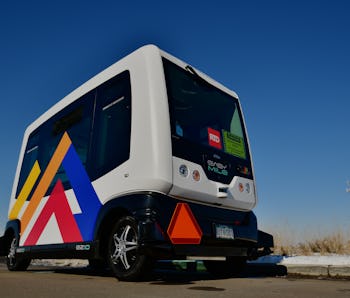Hitting the brakes
EasyMile’s self-driving shuttles lose the privilege to carry passengers until further notice
An incident that injured a rider has prompted a clampdown by U.S. regulators.

French company EasyMile has been forced to stop carrying passengers in its autonomous shuttles by the National Highway Traffic Safety Administration (NHTSA) after an incident in Columbus, Ohio. One of its self-driving vehicles stopped suddenly and a passenger was injured when they fell from their seat, Reuters reports.
The company’s vehicles are still allowed on U.S. streets, but won’t be allowed to carry passengers again until the NHTSA has finished its investigation into the incident. The suspension applies to all of the 16 autonomous shuttles EasyMile has been operating in 10 U.S. states. This isn’t the first time the company has had this problem. Last July a similar incident happened in Utah when an EasyMile shuttle performed an emergency stop.
No passengers? No problem — The NHTSA recently signed off on Nuro’s R2 autonomous delivery vehicle’s proposed testing on public roads and exempted it from some of the requirements that makers of self-driving people carriers face, like side mirrors. The key difference, though, is that the R2 only ferries inanimate objects. The regulator is, understandably, far more cautious when it there are passengers involved.
Uber, for instance, which recently bought nearly 600 acres of land near Pittsburgh to use for testing its self-driving vehicles, had its autonomous dreams temporarily put on hold after a fatal crash with one of its vehicles in Arizona two years ago. Nonetheless, it’s now planning to roll out self-driving vehicles in Washington D.C.
Self-driving is coming, even if the progress is slowed — Delays notwithstanding, autonomous rides are coming. Companies like Bosch, Sony, and chipmaker Qualcomm are all working on self-driving hardware to sell to automakers, and delivery firms are keenly eyeing those same automakers’ progress. The appeal is obvious: 1. Cut out the human driver, 2. Cut down on costs and keep vehicles running all the time, 3. Profit!
UPS is using Waymo’s autonomous vehicles for package deliveries in Arizona, for example. In that instance, there’s still a single human passenger who’s there to take control if necessary. But it’s only a matter of time before that safety measure is no longer necessary.
The race to autonomy is on — Waymo remains one of the sector leaders, with its vehicles having racked up more than 20 million test miles over the last decade, and plans to expand its operations to Texas and New Mexico this year. But Uber, Toyota, Tesla and others continue nipping at its heels. EasyMile’s executives must be feeling relieved their vehicles haven’t been pulled from U.S. roads entirely, and are no doubt working to ensure they can resume carrying passengers soon.
Caution from regulators regarding self-driving tech is essential, but the sooner the various offerings become sufficiently safe for mainstream use, the sooner road fatalities will plummet. Because if you think computers are bad drivers you evidently haven’t spent enough time in traffic with other easily-distracted, texting-obsessed, rage-prone humans.